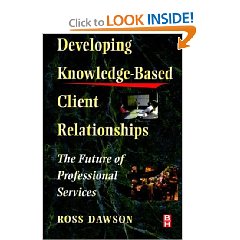Ross Dawson
A great deal of work went into conceptualizing and crafting this book, and I give very high marks to the author, who does a really superb job of integrating insights from knowledge management, information technology, cognitive modeling, and client relationship or account management. This book makes the jump from airplane reading, to “hold and read several times more.”
At the heart of the book, and many appear to miss this on the first reading, is the author's distinction between commoditized information services and differentiated information services. The first, aided by automation, is on a downward spiral in terms of both value and pricing, and competition is fierce. The second, partially aided by automation but ultimately being unique for rising to a higher level of knowledge service delivery that can only be done by expert humans, is where value pricing and differentiation can be found, and where professional services need to go if they are to remain profitable.
The second urgent and valuable insight the author shares with us is the co-evolutionary nature of a service that evolves through constant knowledge transfer to the client and constant co-creation of new knowledge as the competitive advantage; and a very deep and broad relationship with the client at all levels of both organizations. One leads to the other, the other leads to finding new business with the same client, and the cycle repeats itself. This insight is especially relevant to all those who are using information technology to force single human account managers to handle more and more accounts remotely, all the while “losing touch” with their clients for lack of time to make the personal visit or personal telephone call. This is also explicitly contrary to the prevailing “black box” model where knowledge is withheld as proprietary–the author makes it clear that in this new era, withheld knowledge is much less valuable and much less survivable–this is a dying model.
Among the sections of the book that I found especially worthwhile, partly for their elegance of expression and partly because they represent a considerable professionalism in distilling vast arrays of writing by others, were those that itemized the seven processes for adding value to the client relationship by adding converting information into knowledge (filtering, validation, analysis, synthesis, presentation, ease of access and use, customization); the rare simplicity of the distinction between implicit and explicit knowledge and how to communicate both kinds of knowledge; the brief but sufficient discussion of four key humans in the loop: the senior representative, the relationship coordinator, the knowledge specialist, and the knowledge customer; and the more general discussion of the various means for communicating knowledge value to the client, both in terms of channels and in terms of events including scenarios and wargaming.
Contrary to the publicity, this is not a case study book, although the several “gray block” inserts are both helpful and credible. This book is an executive primer for managing value in the 21st Century, and it merits several readings, not one.
Where the book falls short, and it may be that this is deliberate and better left for another book, is in the section on pricing knowledge services. Despite a fine summary of the kinds of pricing that are used, from time and materials (both the predominant means and the least profitable) to retainer to contingency to commissions and tenders, one is left feeling that neither the author nor his otherwise excellent sources have really come to grips with the fact that clients are still mired in an industrial-age financial mindset that values fixed goods and is not yet ready to pay for intangible knowledge goods. My own research suggests that fully half of the competition for knowledge professionals comes from client middle managers and senior sales or production experts who believe that they know everything they need to know to make good decisions–the other half comes from niche providers of very fragmented services, from the aggregators of online information (Factiva, Lexis-Nexis, DIALOG) to the market research firms (FIND/SVP, Fuld, SIS) to private investigative groups (Arkin, Kroll, IGI) to academic consultants (Harvard, UT) to localized information brokers listed in the Burwell Directory…and many many other sources including commercial imagery and Russian military maps of third world regions that most knowledge specialists–as well as their clients–overlook completely. Somewhere in all this mix, the big accounting and legal firms are trying to leverage their access to clients by becoming portals to global knowledge, and they are *not* delivering the integrated value they should–a value that can only come when the author's wisdom becomes conventional, and every professional services person knows how to define the question, discover and validate the sources, discriminate and distill the many sources into a value-added compelling presentation, and do so in timely easy to use fashion.
Some will be deceived by the very easy to read and well-organized sections into thinking this book is slightly superficial. That is not the case. This is a very well researched book that represents enormous value-added because the author has creatively distilled and organized at least four separate literatures, and done so in a fashion that will repay multiple readings of the book by the new standard: at least twice the value of your time taken for each reading.





